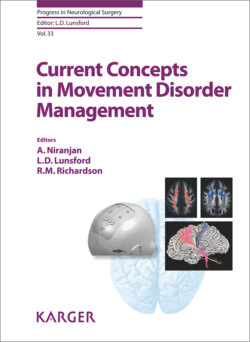Читать книгу Current Concepts in Movement Disorder Management - Группа авторов - Страница 50
Essential Tremor
ОглавлениеET is very common and more frequent in older adults, with prevalence estimates of 0.4% overall and 4.6% in those aged 65 or older [12]. The clinical syndrome is comprised of action tremor in the upper extremities, typically 6–12 Hz in frequency, with variable involvement of the head, voice, tongue, face, and lower extremities. The diagnosis of ET is made when the clinical syndrome is seen in the absence of any metabolic or toxic cause, and no other neurologic signs are present to suggest an alternative primary disorder, such as dystonia or a Parkinsonian syndrome. A positive family history and response to alcohol can help support a diagnosis of ET.
In ET, the onset of postural kinetic tremor in the hands is gradual and largely symmetric. In most cases, the progression of tremor is very slow, over a number of years. The tremor may remain mild, never prompting a patient to seek medical evaluation, or it may cause progressive functional impairment, such as difficulty with eating, drinking, and writing. The progression of tremor severity has been reported mostly in clinic-based studies, which are biased towards more severe disease progression. True population-based studies are lacking, but findings from a prospective study of ET patients who were followed up regardless of the need for medical care found the annual increase in tremor severity from baseline to be between 3.1 and 5.3% [13]. The pattern of progression is characterized by increasing amplitude of tremor, decreasing tremor frequency, and involvement of more body regions. Resting tremor is seen in a minority of cases, usually later in the course. In advanced ET, signs of cerebellar disturbance are frequently seen on examination, such as intention tremor, target overshoot, and tandem gait difficulty. The life expectancy is believed to be normal in ET, although recent data from population-based studies suggest that there may be an increased risk of mortality [14].
There is a growing body of evidence challenging the former “benign” characterization of ET, showing that ET is associated with a spectrum of other symptoms, both motor and nonmotor, including cognitive impairment, mood disturbances, gait disorder, and hearing deficits. In addition, ample evidence from epidemiologic studies point to an association between ET and PD, although the exact nature of this association remains unclear. A subset of patients will develop mild Parkinsonian features or full-blown Parkinson disease supported by dopaminergic deficit on functional imaging studies. A prospective population-based study reported that patients with ET had a 4-fold risk of developing incident PD during follow-up [15]. Furthermore, the onset of ET later in life has been found to increase the risk of incident Alzheimer disease by nearly 2-fold [16]. These associations, along with the pathologic findings of Purkinje cell loss, lead some experts to view ET as a neurodegenerative disease.
Pharmacologic treatments in ET provide only about 50% mean tremor reduction and are frequently limited by side effects. Propranolol and primidone have Class A evidence and are considered first line therapies for ET. Combination therapy is often more effective than monotherapy. Alternative agents with variable reported efficacies include topiramate, gabapentin, and benzodiazepines. Side effects, however, are problematic. In a study of 528 patients with ET, more than half of the patients treated with the 4 most commonly used medications had stopped their medication [17]. Botulinum toxin injections have been investigated for hand tremor in ET but the data overall showed modest tremor reduction and high rates of wrist and finger weakness [18]. However, botulinum injections may be a reasonable option for the treatment of head or voice tremor, which tends to respond poorly to medications.
When medications prove ineffective or intolerable, surgical approaches have been performed with good success rates overall. The ventral intermediate nucleus of the thalamus is the standard surgical target in ET. Both unilateral thalamotomy and DBS have demonstrated safety and good efficacy for long-term management of tremor. Bilateral thalamotomy is generally avoided due to high incidence of complications, but bilateral DBS is feasible and has become the favored surgical treatment for ET. Dysarthria and impaired balance are the most common complications of bilateral thalamic DBS. Surgical therapies have variable effect on midline tremors, but some patients who undergo bilateral surgery for hand tremor also find a reduction in head and voice tremor.
